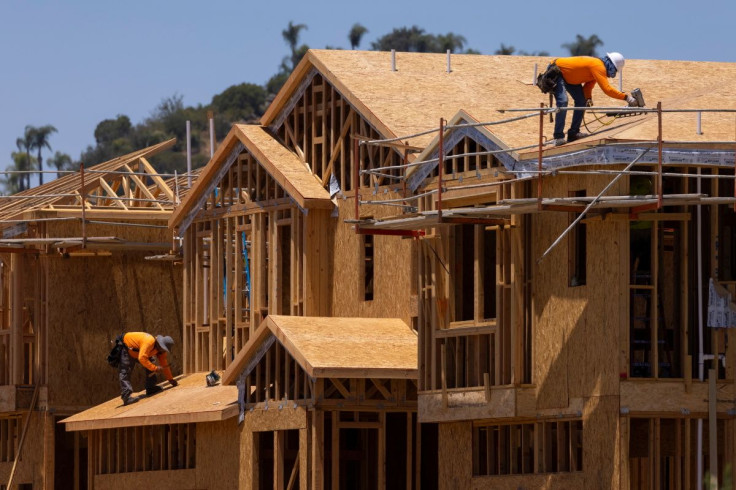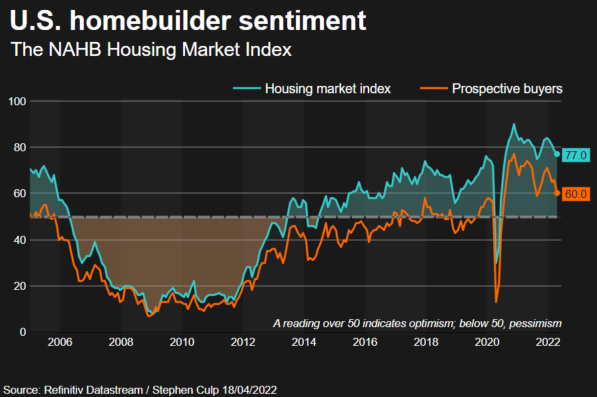U.S. Homebuilder Sentiment Drops To Seven-month Low Amid Surging Mortgage Rates

Confidence among U.S. single-family homebuilders fell to a seven-month low in April as surging mortgage rates and snarled supply chains boosted housing costs, shutting out some first-time buyers from the market, a survey showed on Monday.
The housing market is under the spotlight as the Federal Reserve adopts an aggressive monetary policy stance in its fight against sky-high inflation, sending the 30-year fixed mortgage rate above 5% for first time in over a decade.
But with housing inventory at record lows, the blow from surging borrowing costs could be modest.
"The extreme supply-demand imbalance in today's housing market will likely dampen the hit to activity from higher rates," said Ronnie Walker, an economist at Goldman Sachs.
The National Association of Home Builders/Wells Fargo Housing Market index dropped two points to 77 this month. The fourth straight monthly decline pushed the index to its lowest level since last September. A reading above 50 indicates that more builders view conditions as good rather than poor.
Homebuilding sentiment dropped to its lowest level in nearly two years in the Midwest. It also fell in the West, but rose in the Northeast and edged up in the densely populated South.
Graphic: NAHB -

Shortages as well as the high cost of building materials such as framing lumber are making it difficult for builders to ramp up production.
According to government data, the backlog of houses approved for construction but yet to be started hit an all-time high in February. Homebuilding and housing permits likely slipped in March, a Reuters survey of economists predicted. March's housing starts report is scheduled to be published on Tuesday.
"Policymakers must take proactive steps to fix supply chain issues that will reduce the cost of development, stem the rise in home prices and allow builders to increase production," said NAHB Chairman Jerry Konter in a statement.
The Fed in March raised its policy interest rate by 25 basis points, the first hike in more than three years. Economists expect the U.S. central bank will hike rates by 50 basis points next month, and soon start trimming its asset portfolio.
REDUCED AFFORDABILITY
The 30-year fixed-rate mortgage averaged 5.0% during the week ending April 14, the highest since February 2011, up from 4.72% in the prior week, according to data from mortgage finance agency Freddie Mac.
More expensive building materials and higher mortgage rates are raising the cost of buying a house, making home purchasing less affordable, especially for lower-income groups and first-time home buyers.
At the current mortgage rate, economists estimate consumers taking a $300,000 home loan would pay $263 more per month than if they had fixed the loan rate at the beginning of this year.
Annual house prices continue to post double-digit growth. Consumers expected home prices and rents to rise sharply this year, a separate survey by the New York Fed showed on Tuesday.
Renters reported seeing just a 43.3% likelihood of ever owning a home, down from 51.6% in 2021 and the lowest reading since the survey began in 2014.
"Rising mortgage rates and the run-up in prices in recent years will worsen affordability but pent-up demand from consumers will keep house price growth strong," said Abbey Omodunbi, a senior economist at PNC Financial in Pittsburgh, Pennsylvania.
Goldman Sachs estimates that sales of previously owned homes will drop about 6.0% to an annualized pace of 5.8 million units this year from the fourth quarter of 2021. It also expected house price inflation to remain strong this year.
"While higher mortgage rates will help to slow home price growth by reducing the imbalance between supply and demand, our model suggests that the current level of housing market tightness and blistering pace of recent home price growth will support just over 10%, fourth quarter/fourth quarter, home price growth this year," said Goldman Sachs' Walker.
"We expect home price growth to slow more substantially beyond this year. Our model points to a pace of home price growth in the low single digits by mid-2023, a pace we previously did not expect to reach until 2024."
The NAHB survey's measure of current sales conditions fell to a seven-month low of 85 from 87 in March. But its gauge of sales expectations over the next six months rose three points to 73. The component measuring traffic of prospective buyers declined six points to an eight-month low of 60.
© Copyright Thomson Reuters 2024. All rights reserved.




















